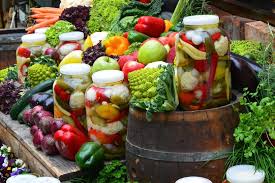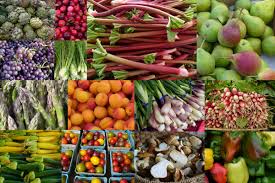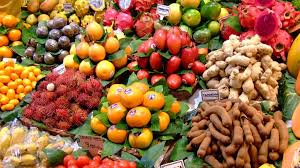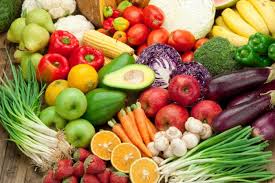In this article, the focus is on exploring different types of vegetables and fruits, their uses, storage methods, and preservation techniques. Fresh vegetables and fruits are vital foods from both economic and nutritional perspectives.
Types of Vegetables
Vegetables are categorized as follows:
- Roots
- Tubers
- Bulbs
- Leafy
- Roots and Stems
- Brassicas
- Pods and Seeds
- Fruiting
- Stems and Shoots
- Mushrooms and Fungi
| Roots | Tubers | Bulbs | Leafy | Roots and Stems | Brassicas | Pods and Seeds | Fruiting | Stems and Shoots | Mushrooms and Fungi |
|---|---|---|---|---|---|---|---|---|---|
| Beetroot | Cassava | Celery | Chicory | Thai beans | Broccoli | Broad beans | Aubergine/Eggplant | Asparagus | Ceps |
| Carrots | Jerusalem artichokes | Garlic | Chinese leaves | Fallow wax beans | Brussels sprouts | Butter or lima beans | Courgette/Zucchini | Cardoon | Chanterelles |
| Celeriac | Potatoes | Leeks | Corn salad | Fiddlecoke fern | Cabbage | Common beans | Cucumber | Celery | Candy caps |
| Ginger | Sweet potatoes | Onions | Fluted pumpkin leaves | Palm hearts | Cauliflower | Runner beans | Gourds | Endive | Morels |
| Horseradish | Yams | Shallots | Kuka leaves | Water chestnuts | Curly kale | Mange-tout | Marrow | Globe artichokes | Mushrooms |
| Parsnips | Spring onions | Lagos bologi/Water leaf | Samphire | Spring greens | Okra | Peppers | Sea kale | ||
| Radish | Lettuce | Peas | Pumpkin | ||||||
| Salsify | Mustard and cress | Peanut | Squash | ||||||
| Scorzonera | Radicchio | Soya beans | Tomatoes | ||||||
| Swedes | Sorrel | Sweet corn | |||||||
| Tiger nut | Spinach | ||||||||
| Turnips | Swiss chard | ||||||||
| Watercress |
Read Also: How to Extract and Package Snail Slime (Snail filtrate) for Commercial Use
Nutritional Value of Vegetables

- Root Vegetables: Contain starch or sugar for energy, small but valuable amounts of protein, mineral salts, vitamins, cellulose, and water.
- Green Vegetables: Store little protein or carbohydrate in leaves but are rich in mineral salts (calcium, iron) and vitamins, particularly vitamin C and carotene. The greener the leaf, the higher the vitamin content.
Preservation of Vegetables
- Canning: Artichokes, asparagus, carrots, celery, beans, peas (fine, garden, processed), tomatoes (whole, puree), mushrooms, and truffles are preserved in tins.
- Dehydration: Onions, carrots, potatoes, and cabbage are shredded and dried to 5% water content.
- Drying: Legume seeds (peas, beans) are dried to 10% moisture.
- Pickling: Onions and red cabbage are preserved in spiced vinegar.
- Salting: French and runner beans are sliced and preserved in dry salt.
- Freezing: Peas, beans, sprouts, spinach, and cauliflower are deep-frozen.
Detailed Types of Vegetables
A. Roots
- Beetroot: Available in round and long varieties; used for soups, salads, and as a vegetable.
- Carrots: Grown in numerous varieties and sizes; used for soups, sauces, stocks, stews, salads, and as a vegetable.
- Celeriac: Large, light-brown, celery-flavored root; used in soups, salads, and as a vegetable.
- Horseradish: Long, light-brown, narrow root; grated for horseradish sauce.
- Mooli: Long, white, thick radish family member; used for soups, salads, or as a vegetable.
- Parsnips: Long, white, tapering root with a nut-like flavor; used in soups, casseroles, and as a vegetable (roasted, pureed).
- Radishes: Small, round, or oval summer variety; served with dips, in salads, or as a vegetable in white or cheese sauce.
- Salsify: Long, narrow root, also called oyster plant due to its taste; used in soups, salads, and as a vegetable.
- Scorzonera: Long, narrow, slightly astringent root; used in soups, salads, and as a vegetable.
- Swede: Large root with yellow flesh; mashed, parboiled, roasted, or added to stews.
- Turnip: Available in long and round varieties; used in soups, stews, and as a vegetable.
B. Tubers
- Jerusalem Artichokes: Potato-like tuber with a bittersweet flavor; used in soups, salads, and as a vegetable.
- Purple Congo: A blue potato; Truffle de Chine is a deep purple potato grown in France.
- Taro: Found in tropical areas in two varieties: large barrel-shaped and smaller “eddo or dasheen”; dark mahogany brown with shaggy skin.
- Potatoes: Sold by name (e.g., King Edward, Desiree, Maris Piper) for specific cooking purposes; categorized as floury, firm, waxy, or salad potatoes. Jersey Royals are prized new potatoes.
- Sweet Potatoes: Long tubers with purple or sand-colored skins and orange flesh; sweet, aromatic flavor; used fried, pureed, creamed, candied, or in sweet puddings.
- Yams: Cylindrical, often knobby; used similarly to sweet potatoes.
C. Bulbs
- Fennel: Swollen leaf base with a pronounced flavor; used raw in salads or cooked.
- Garlic: Onion-like bulb with papery skin and small cloves; pungent, used sparingly in many dishes.
- Leeks: Summer leeks have long white stems and mild flavor; winter leeks have stockier stems and stronger flavor; used in stocks, soups, sauces, stews, hors d’oeuvres, and as a vegetable.
- Onions: Various types with different colored skins and flavor strengths; widely used in cookery except sweet dishes.
- Shallots: More refined flavor than onions; used in high-end cookery.
- Spring Onions: Slim, miniature leek-like; used in soups, salads, and Chinese/Japanese dishes. Ramps are stronger-flavored.
D. Leafy
- Chicory: Coarse, crisp leaves with a sharp, bitter outer taste and milder inner leaves.
- Chinese Leaves: Long, white, densely packed leaves with a celery-like flavor; used as a lettuce substitute or boiled, braised, or stir-fried.
- Corn Salad: Also called lamb’s lettuce; small, tender, dark leaves with a tangy, nutty taste.
- Culaboo: Leaves of the taro plant, poisonous raw but used in Asian and Caribbean cooking when cooked.
- Lettuce: Varieties include cabbage, cos, little gem, iceberg, oakleaf, Webbs; used for salads or as wraps for foods like fish fillets.
- Mustard and Cress: Embryonic mustard and cress leaves with a sharp, warm flavor; used in sandwiches, salads, or as a garnish.
- Nettles Brache: Young leaves lose sting when cooked; used in soups.
- Radicchio: Deep red chicory with white ribs and a bitter taste.
- Rocket: Large-leaved cress with a peppery taste.
- Sorrel: Bright-green, sour leaves; best young for salads and soups.
- Spinach: Tender, dark green leaves with a mild, musky flavor; used in soups, egg/fish garnishes, as a vegetable, or raw in salads.
- Swiss Chard: Large, ribbed, curly leaves with a milder flavor than spinach; used similarly.
- Watercress: Long stems with round, dark, tender leaves and a peppery flavor; used in soups, salads, and as a garnish for roasts and grills.
- Vine Leaves: Young grape vine leaves are edible.
E. Brassicas
- Broccoli: Includes calabrese, white, green, purple-sprouting; delicate with a gentle flavor; used in soups, salads, stir-fries, and as a vegetable.
- Broccoflower: A broccoli-cauliflower cross; Chinese broccoli is a leafy variety with slender flower heads.
- Brussels Sprouts: Small green buds on thick stems; used in soups or as a vegetable in various preparations.
- Cabbage: Three types (green, white, red); varieties include early green, Savoy, and white for coleslaw; used boiled, braised, or stir-fried.
- Chinese Mustard Greens: Deep green, mustard-flavored.
- Pok Choi: Chinese cabbage with many varieties.
- Cauliflower: Creamy-white florets with a distinctive flavor; used in soups and as a vegetable.
- Kale and Curly Kale: Thick green leaves; curly kale is most popular.
- Romanesco: Green or white broccoli-cauliflower cross.
F. Pods and Seeds
- Broad Beans: Pale-green, oval beans in thick pods; young beans cooked in shells, older ones shelled; used as a vegetable.
- Butter or Lima Beans: Butter beans are large, white, flat; lima beans are smaller; used in salads, stews, or casseroles.
- Runner Beans: Bright green, velvety when young; stringy if old; used as a vegetable.
- Mange-tout: Also called snow peas or sugar peas; flat pods with immature seeds, eaten whole after preparation; used in salads, stir-fries, or as a vegetable.
- Okra: Curved, pointed seed pods with an aubergine-like flavor; used as a vegetable or in creole stews.
- Peas: Include garden peas, petits pois, and dried marrowfat peas; used in soups, salads, stews, stir-fries, or as a vegetable.
- Sweet Corn: Also known as maize or Sudan corn; available on the cob (fresh/frozen) or in kernels (canned/frozen); used in soups, salads, casseroles, or as a vegetable.
G. Roots and Stems
- Thai Beans: Similar to French beans.
- Fallow Wax Beans: Similar to French beans.
- Fiddlecoke Fern: Also called ostrich fern; 5 cm long, used in oriental dishes like asparagus.
- Palm Hearts: Buds of cabbage palm trees.
- Water Chestnuts: Nut-like fruit of aquatic herbs, often Chinese sedge.
- Samphire: Marsh samphire (glasswort, sea asparagus) grows in estuaries; white rock samphire (sea fennel) grows on rocky shores.
H. Fruiting
- Aubergine: Elongated, purple-red to purple-black with white flesh; requires seasonings (e.g., garlic, lemon, herbs); sliced, fried, baked, steamed, or stuffed.
- Avocado: Used as a vegetable due to its bland, nutty flavor; summer variety ripens purple-black, winter variety is pear-shaped with green skin; used in soups, salads, dips, or garnishes.
- Courgette: Baby marrow, light to dark green; delicate flavor enhanced by herbs, garlic, or spices; boiled, steamed, fried, baked, stuffed, or stir-fried.
- Cucumber: Long, smooth, dark green; used in salads, soups, sandwiches, garnishes, or as a vegetable.
- Gourds (Exotic): Include bottle gourds, chayotes (chow-chow), Chinese butter lemons.
- Marrow: Long, oval gourds with bland flavor; cooked like courgettes.
- Peppers: Green (unripe), yellow, orange, or red; used raw, cooked, stuffed, baked, in casseroles, or stir-fried.
- Pumpkins: Vary in size up to 50 kg (110 lb); used in soups or pumpkin pie, also for Halloween decorations.
- Squash: Varieties include acorn, butternut, summer crookneck, delicate hubbard, kuboche, onion; boiled, baked, steamed, or pureed.
- Tomatoes: Widely used in soups, sauces, stews, salads, sandwiches, and as a vegetable; varieties include cherry, yellow, globe, beef, and plum.
I. Stems and Shoots
- Asparagus: White (mild), French (violet/blue tips, astringent), green (aromatic); used in all courses except sweets.
- Bean Sprouts: Soya or mung bean sprouts; used in stir-fries, salads, or as a vegetable.
- Cardoon: Long, grey-green plant with fleshy, ribbed stalks; used cooked or raw in salads.
- Celery: Long, ribbed, white to light green stalks; used in soups, stocks, sauces, cooked, or raw in salads/dips.
- Chicory: Also Belgian endive; conical, crisp, bitter white leaves; used cooked or raw.
- Globe Artichokes: Fat pine cone-like with inedible green leaves and edible fleshy base; served hot/cold, boiled, stuffed, baked, or in casseroles.
- Kohlrabi: Turnip-shaped stem; best at large egg size for cooking; used as a vegetable, stuffed, baked, or in stews.
- Sea Kale: Delicate white leaves with yellow frills and purple edges; boiled, braised, or served raw like celery.
J. Plantains
- Ackee: Tropical fruit used in Caribbean savory dishes.
- Breadfruit: Tropical fruit from South Pacific islands.
K. Mushrooms and Fungi
- Ceps: Wild mushrooms with stout stalks, raised veins, and brown spores.
- Chanterelles or Girolles: Wild, funnel-shaped, yellow-capped with ribbed stalks.
- Horns of Plenty: Trumpet-shaped, shaggy, almost black wild mushrooms.
- Morels: Delicate, wild, pale beige to dark brown-black with a meaty flavor.
- Oyster Mushrooms: Creamy gills, firm flesh, delicate flavor, shorter storage life.
- Shiitake Mushrooms: Solid texture, strong, meaty flavor.
- Field Mushrooms: Found in meadows, creamy white cap/stalk, strong earthy flavor.
- Cultivated Mushrooms: Button (small, succulent, mild), cap, and open/flat varieties; used in soups, stocks, salads, vegetables, savories, and garnishes.
Read Also: The Health Benefits of Using Accent Seasoning on your Cooking
Fruits

Fruits are grouped for culinary purposes as follows:
- Stone Fruits
- Hard Fruits
- Soft Fruits
- Citrus Fruits
- Tropical and Other Fruits
- Melons
Nutritional Value of Fruits
Fruits are valued for their vitamin C content, making them protective foods. Their cellulose provides roughage.
Storage of Fruits
- Hard fruits (e.g., apples) are kept in boxes in a cool store.
- Soft fruits (e.g., raspberries, strawberries) remain in punnets or baskets in a cold room.
- Stone fruits are placed in trays to identify and discard damaged fruit.
- Peaches and citrus fruits stay in delivery trays or boxes.
- Bananas avoid overly cold storage to prevent blackened skins.
Quality and Purchasing Points for Fruits
- Soft fruits deteriorate quickly if damaged or overripe; they should appear fresh, without shrinking, wilting, or mold.
- Color indicates ripeness in strawberries and dessert gooseberries.
- Hard fruits (e.g., apples, pears) should be free of bruises; pears should not be overripe.
Preservation of Fruits
- Drying: Apples, pears, apricots, peaches, bananas, figs (plums become prunes; grapes become currants, sultanas, raisins).
- Canning: Most fruits canned in syrup; apples packed in water (solid packed).
- Bottling: Cherries bottled in maraschino; less common commercially.
- Candied, Glacé, Crystallized Fruits: Mainly imported from France.
- Jam: Made from stone and soft fruits.
- Jelly: Produced from fruit juice.
- Quick Freezing: Strawberries, raspberries, loganberries, apples, blackberries, gooseberries, grapefruit, plums; stored below 0°C (32°F).
- Cold Storage: Apples stored at 1–4°C (34–39°F), depending on variety.
- Gas Storage: Controlled atmosphere with limited air, reduced oxygen, and increased carbon dioxide to slow respiration.
Uses of Fruits
Most fruits (except lemon, rhubarb, cranberries) are eaten raw or as desserts. Apples, pears, cherries, and gooseberries have dessert and cooking varieties.
i. Stone Fruits
- Damsons, Plums, Greengages, Cherries, Apricots, Peaches, Nectarines: Used as desserts, stewed (compote), in jams, pies, puddings, sweet dishes, and some meat/poultry dishes. Peaches garnish certain meat dishes. Plum varieties include Dessert, Victoria, Gamota, Mayoris, Burbank, Cooking, Angelina, Stanley, Beech Cherry, Reeves Seedling.
ii. Hard Fruits
- Apples: Dessert varieties include Beauty of Bath, Discovery, Spartan, Worcester Pearmain, Cox’s Orange Pippin, Blenheim Orange, Laxton’s Superb, James Grieve; imported include Golden Delicious, Braeburn, Gala. Bramley is the top cooking apple. Used in pastry dishes, as garnishes for meat, and in sauces for roast pork/duck.
- Pears: Best-known varieties include William, Conference, Doyenne du Comice, Anjou, Beurre-Beth, Beurre-Bosc, Beurre-Hardy, Beurre-Superfin, Forelle, Merton Pride, Rocha, Hosui, Perry, Tientsin. Used in pastry dishes.
iii. Soft Fruits
- Raspberries, Strawberries, Loganberries, Gooseberries: Used as desserts.
- Gooseberries, Black/Red Currants, Blackberries: Stewed, used in pies, puddings, jams, flavorings, and sauces for sweet, meat, and poultry dishes.
iv. Citrus Fruits
- Oranges, Lemons, Limes, Grapefruit: Rarely cooked except for marmalade. Lemons/limes flavor and garnish fish dishes; oranges flavor fruit salads and garnish poultry.
- Grapefruit: Served at breakfast or as a luncheon first course.
- Mandarins, Clementines, Satsumas: Eaten as desserts or used in sweet dishes.
- Kumquats: Tiny, orange-like, eaten with skin.
- Tangelos: Tangerine-grapefruit cross, sometimes called uglis.
- Pomelos: Largest citrus, round with a flattened base and pointed top.
v. Tropical and Other Fruits

- Bananas: Used as desserts, grilled for fish garnishes, fried as fritters, or in poultry dishes (Maryland), fruit salads, and sweet dishes.
- Cape Gooseberries: Sharp, pleasant-flavored, small, round; sometimes dipped in fondant for petit fours.
- Carambola (Star Fruit): Yellowish-green, waxy, long, narrow with a delicate lemon flavor.
- Cranberries: Hard red berries for cranberry sauce, served with roast turkey.
- Dates: Whole as desserts; stoned in sweet dishes and petit fours.
- Figs: Fresh as first courses or desserts; dried in fig puddings and sweet dishes.
- Granadillas: Orange-shaped, light, with passion fruit-like flavor.
- Grapes: Black/white varieties used as desserts, in fruit salads, sweet dishes, or fish garnishes.
- Guavas: Walnut to apple-sized; sweet pink flesh, eaten with cream or mixed with other fruits.
- Kiwi Fruit: Brown, furry skin with green flesh and edible black seeds; decorative when sliced.
- Lychees: Chinese fruit, delicate flavor, available tinned or fresh.
- Mangoes: Melon to apple-sized; smooth pinky-golden flesh; served with lemon juice, sugar, rum, or ginger, or in fruit salads and sorbets.
- Mangosteens: Apple-shaped, reddish-brown to purple skin, juicy creamy flesh.
- Bubacos: Papaya hybrid.
- Custard Apples: Heart-shaped or oval, light tan or greenish quilted skin. Soursops (prickly custard apples) have dark green, spiny skin.
- Curuba (Banana Passion Fruit): Soft yellowish skin.
- Dragon Fruit: Yellow or pink, large (10 cm), with pointed green-tipped scales; green, jelly-like flesh with edible seeds.
- Durians: Large (up to 4.5 kg), woolly olive-green with stubby spikes; creamy white, custard-like flesh.
- Feijoa: Guava family member, small, pear-shaped, dark green skin that yellows when ripe.
- Jackfruit: Large, irregularly shaped, rough spiny skin; ripens from green to brown.
- Jujubes (Chinese Jujubes, Apples, or Dates): Small, greenish-brown fruit.
- Kiwanos (Horned Melon, Horned Cucumber, Jelly Melon): Oval, golden-orange skin with spikes; green, jelly-like flesh with edible seeds.
- Loquats (Japanese Medlar): Sweet-scented, delicate mango-like flavor.
- Maracuyas (Yellow Passion Fruit): Vibrant green, thick, shiny skin turning yellow; orange pulp with hard grey seeds.
- Pepinos (Tree Melon): Smooth golden skin with purple streaks, native to Peru.
- Pomegranates: Apple-shaped, leathery reddish-brown skin; creamy-white edible seeds in pink/crimson pulp.
- Prickly Pears (Indian Figs): Cactus fruit, greenish-orange skin, orangey-pink, melon-like flesh.
- Rambutans (Hairy Lychees): Creamy flesh in four segments, each with a large inedible brown stone.
- Sapodillas: Oval, tight brown skin, sweet flesh with inedible black pips.
- Tamarillos (Tree Tomatoes): Large, egg-shaped, wine-red skin; two lobes with black seeds.
- Passion Fruit: Egg-sized, crinkled purple-brown skin; edible flesh and seeds used in pastry work.
- Paw Paw (Papaya): Green to golden skin, orangey flesh, sweet subtle flavor with black seeds; eaten raw with lime/lemon juice or with crab/prawns and mayonnaise.
- Persimmon: Round, orange-red, tough skin; sweet when ripe, tannic when under-ripe.
- Pineapple: Used as a dessert, in sweet dishes, or as a garnish for meat dishes.
- Rhubarb: Used in pies, puddings, fool, and compote.
- Sharon Fruit: Seedless persimmon, sweet, exotic peach-like flavor.
- Tamarind: Red, egg-shaped, tomato-apricot-coconut flavor; used in sweet dishes and salads.
vi. Melons
- Honeydew: Long, oval, dark green skin; white flesh with a greenish tinge.
- Charentais: Small, round, mottled green/yellow skin; orange flesh.
- Cantaloup: Large, round, mottled orange/yellow skin with regular indentations; light orange flesh.
- Ogen: Small, round, mottled green skin; suitable for one portion, used in desserts, hors d’oeuvres, and sweet dishes.
Do you have any questions, suggestions, or contributions? If so, please feel free to use the comment box below to share your thoughts. We also encourage you to kindly share this information with others who might benefit from it. Since we can’t reach everyone at once, we truly appreciate your help in spreading the word. Thank you so much for your support and for sharing!

